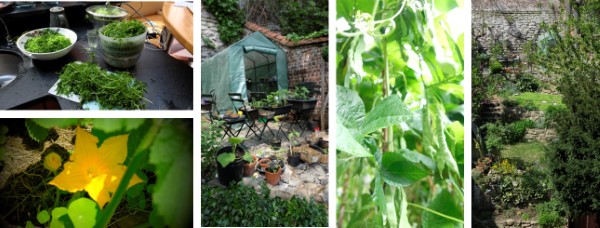
A vertical Brussels garden

A vertical Brussels garden in Covid times * by Hannes Lorenzen, September 2020
We are among the lucky urban gardeners in Covid times.
Our garden is vertical, like our house is. That is how Michael Dower put it when he was staying with us in Brussels. The house is five and a half metres wide, 16 metres long and 5 floors high. The garden follows that shape uphill: 5,5 metres wide and 30 metres long. When we moved in, the garden was just a mere slope with 18% gradient. To make good use of the land we have built 8 terraces with natural stone walls and wood, a tool shed, and we planted small hedges and fruit trees.
We have always enjoyed this little green spot behind our house. But when Brussels came under lockdown in spring this year, we realised our blessings. The garden for once got our full attention. The many collected seeds from seed savers and gardener friends found their way into the ground and pots; their offsprings were carefully protected from slugs and mice; they were animated and arranged to grow together in mutual support, like tomatoes with maize and beans; and they got watered when they needed it in dry periods.
For sprouting and early spring time we have a mobile greenhouse which we set up around March or April and fold it away in July. Step by step all young plants are planted out in various beds. This year we also used high planting beds on our balconies where the sun is more intensive in the afternoon. We use rainwater collected from the roof, as long as it is available. Using water from the tap is restricted to the edible plants and some precious flowers. This especially dry summer we had to use quite a lot unfortunately.
We collect our own seeds every year to share with friends and to reuse next year. We have the impression that seeds have well adapted to our soil and specific light conditions. We make our own compost from kitchen and garden leftovers. Our two children living nearby with their families deliver their scraps in bokashi containers (effective microorganisms). Bokashi is an anaerobe composting method in small quantities which accelerates final composting and offers a liquid which is a fabulous organically fermented manure.
We had used mustard and cress as soil cover this year, which we harvested for salad and spring soup when plants were ready to leave the greenhouse and grow in beds. We left the cress plants as soil cover while cutting it short and froze the greens. We had a lot of cherries this year, Reine Claude plums, a lot of blackberries, black currant, red grapes, and colorful and delicious tomatoes. Green beans which we got from Peliti seed savers in Greece waited until July/August to fully flower and then produced beans in great abundance in September. The “vertical beans field” grew four meters high and became the “jungle” for our grandchildren. We had a single artichoke which produces a beautiful flower if you let it happen. Pumpkins and green winter cabbage are still waiting for the colder season.
The truth is that the beauty and abundance grew in the green hands and due to the uninterrupted presence of Christine, who stayed in Brussels all summer, while I had escaped to Pellworm island. While I was happily watching the “evolutionary rye” grow
and enjoyed its harvest, she made sure that all plants had her full attention. She also managed the peak abundance of vegetables, so that they found their way into fermented conservation, which is another story about healthy food Simone will tell you about.
We are of course far from being able to feed ourselves on this small urban plot, of which we just use a third for vegetables. But we observe, learn and discover every year how the garden works on us. It is a treat for the grandchildren too, especially in Covid times while others are enclosed in small apartments.
